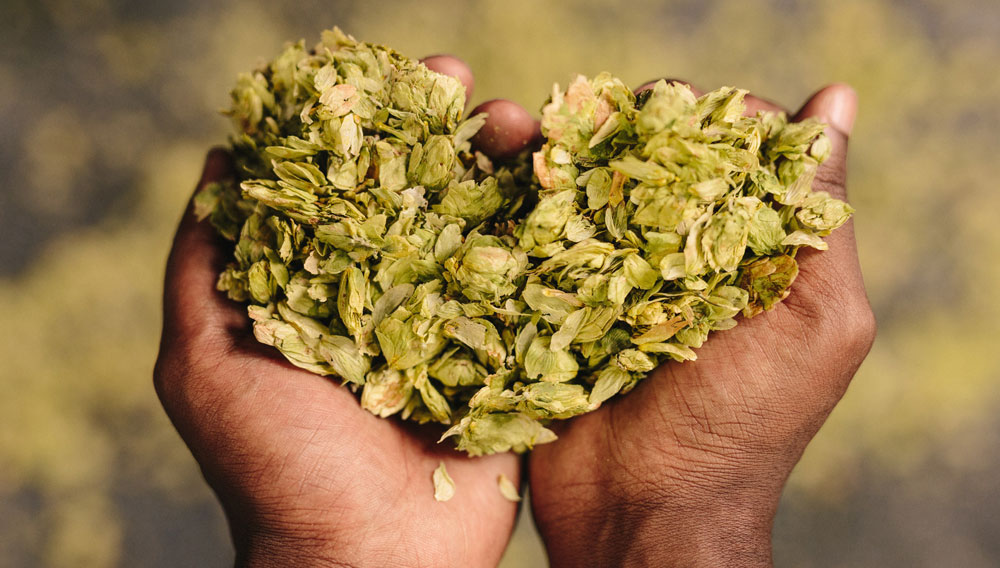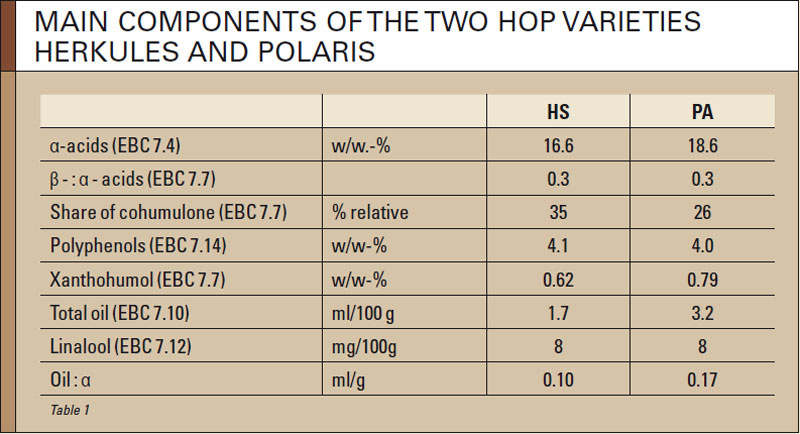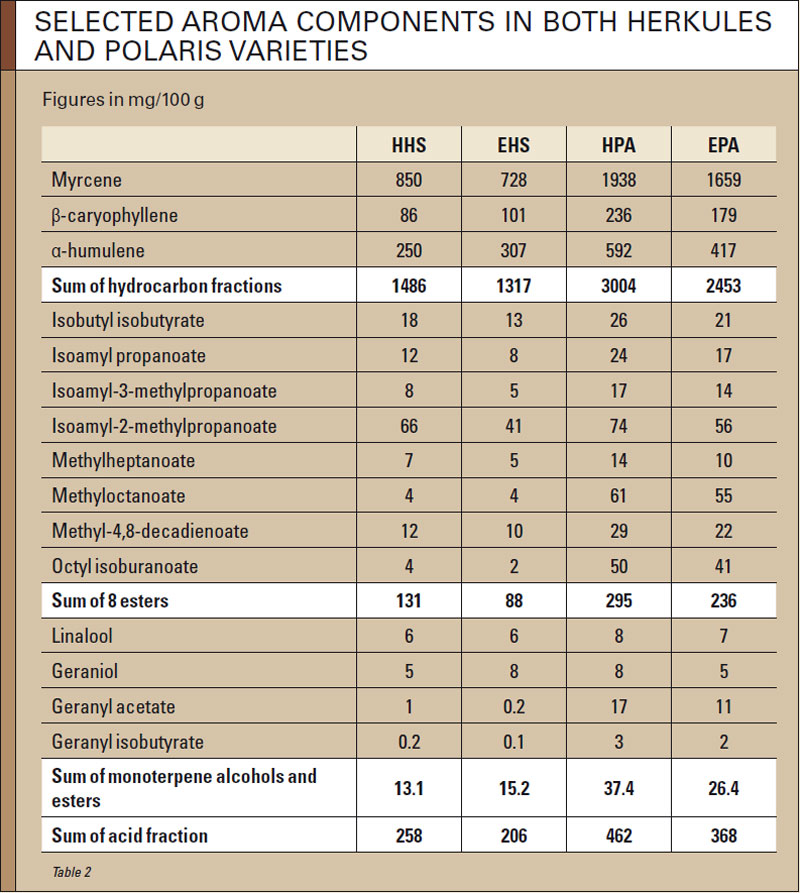Comparison of hop varieties: Herkules and Polaris
High-alpha hops | Herkules is a high-alpha variety bred in Germany and, with 4584 ha (2016) under cultivation, it accounts for the largest growing area in Germany. Within just a few years, it overtook the two varieties, Magnum and Taurus, by a large margin. In 2012, Polaris got the official registration as “Special Flavour Hops” on account of its specific aroma impression. It is grown on 106 ha (2016) in the Hallertau and the Elbe-Saale region. This article deals with the differences between the two varieties from the above-mentioned growing regions. Six brews were produced in order to describe them in the course of the brewing process.
Herkules (HS) has meantime become an established bitter variety on the world market that was able to rapidly win over brewers not only in terms of agronomy, yield and bittering potential (α-acid content and α-yield/ha) but also qualitatively.
Together with three other varieties, Mandarina Bavaria, Hüll Melon and Hallertau Blanc, Polaris (PA) is classified as a special flavour hops. Its aroma is often compared to mint and/or glacier mint sweets and described as fresh-fruity. However, with almost 20 w/w %, the α-acid content of Polaris is so high that its use as bitter hops should be considered for addition at an early stage. There are also some indications that Polaris does better at some locations in the Elbe-Saale region than Herkules. The GfH (Hop Research Centre Hüll) e.g. publishes annually data about areas under cultivation and yields [1]. The edition “Hops – Their Cultivation, Composition and Usage” [2] contains data about both varieties relating to agrotechnical and chemical components that are updated with data about German hop varieties in a new Pocket Guide [3]. A Newsletter from Hopsteiner [4] reports about brewing tests with Herkules and Polaris; the two varieties were added at the beginning of boiling and no significant difference in terms of quality of bitterness and flavour impression was discerned.
Agronomical data
Fig. 1 shows the percentage area under cultivation in ha with high-alpha varieties in Germany in 2016. Fig. 2 is a comparison of α-acid yields in kg/ha of the two varieties, Herkules and Polaris, in the Hallertau (2014 harvest) and the Elbe-Saale (2015 harvest) growing regions. The 2014 Hallertau samples are representative for an average year. Representative samples from the Elbe-Saale region were available only as of 2015.
Though data about the Polaris variety is still limited, it appears that yields in kg/ha in the Hallertau are lower than those of Herkules. It could, however, be the opposite in the Elbe-Saale region.
The new Pocket Guide [3] does not list any preferences in terms of tolerances to diseases. Both varieties are moderately tolerant to Peronospora, mildew and botrytis and are not susceptible to wilt.
Components of both varieties
Standard analyses
The new Pocket Guide [3] publishes a first overview of important components of both varieties. However, a differentiation between the two growing regions is not made in each case. Table 1 lists the data. Two differences are readily apparent:
- The cohumulone share (% relative) of 26 % of total humulone in Polaris is significantly lower than that of Herkules (35 %);
- Polaris contains roughly twice as much hop oil compared to Herkules.
As far as the cohumulone and, consequently, the iso-cohumulone share in beer is concerned, a lower value is regarded rather positively. In “Hopfen – vom Anbau bis zum Bier” (Hops – from growing to the finished beer) [5], the following aspects are mentioned:
- Iso-cohumulone has a slightly harder bitterness;
- iso-cohumulone is less foam-active;
- derivatives of iso-cohumulone increase to a higher extent than those of n- and adhumulone during beer ageing; iso-cohumulone is thus less stable than the other two homologues. This would indicate a slight advantage for Polaris.
In the case of early hopping, different levels of hop oil in high-alpha hops have hardly any influence as most volatile aroma substances are stripped off. If at all, when Polaris, with its high oil content, is added at the beginning of boiling, a weak hop aroma might come to the fore compared to Herkules. This rather subliminal hop aroma, referred to as “kettle hop flavour” [5], might be more likely to make itself noticed when using Polaris with a ratio of oil:α of 0.17 compared to 0.10 for Herkules.
No major differences are noted for total phenol concentration and xanthohumol.
Special analyses
For both varieties of the 2013 and 2014 harvests, lower molecular weight polyphenols were analysed using HPLC [5] as well as aroma components using GC-FID according to Mebak [6]. Both varieties differed slightly in terms of composition of low molecular weight polyphenols [7]. As this difference has no effect on beer quality, it is not shown here.
Table 1 shows that Polaris has a substantially higher hop oil content.
This is also evident when looking at individual components in table 2 (both varieties, both from the Hallertau).
A significantly higher dosage of non-polar and readily volatile mono- and sesquiterpenes such as myrcene, β-caryophyllene and humulene, contributed by Polaris and added at the beginning of boiling, has practically no effect on beer aroma because they are largely evaporated during wort boiling. The more readily soluble oxygen fraction (OF), a plus of 80 % in Polaris compared to Herkules, might contribute to a slightly more fruity beer aroma in some instances.
Fig. 3 shows the sum of the eight carboxylic acid esters as well as of the monoterpene alcohols and esters, representing the average value of both growing regions. Methyl octanoate, octyl isobutanoate, geranyl acetate und geranyl isobutyrate were used as examples of particularly noticeable, variety-specific higher levels for Polaris, between 15 to 23 times higher compared to Herkules.
Hence, Polaris has a more pronounced aroma potential than Herkules that, depending on the brewery, may be perceived as a subliminal fruity aroma when bitter hops are added at the beginning of boiling.
Brewing tests
A total of six brews were produced in the 2 hl research brewery in St. Johann, having the following attributes:
- Bottom-fermented lager with an original gravity of 11.5-12.0 w/w %;
- bitterness to be achieved in the pellet beers was 20 IBU and 15 IBU in the extract beers;
- hop addition at the beginning of boiling.
In these tests, wort boiling deviated from the standard boiling regime (70 min boiling time):
- 20 min hot holding time without hops at 95 °C;
- hopping and subsequent boiling in an internal boiler for 50 min.
The hot holding time was intercalated to monitor DMS/DMS-P, boiling time was simultaneously shorter to save energy. A possibly lower rate of isomerisation was accepted in order to give some hop aroma substances an opportunity to survive boiling and exhibit a “kettle hop aroma”, also at a lower rate of evaporation.
Table 3 is an overview of hopping of the six beers, including product, variety, growing region and year of harvest. 9 g of alpha-acids per hectolitre were generally dosed. Publishing the ususal beer analyses in this article is dispensed with because reproducibility of the pilot plant, tested several times, was also without question in these tests.
Table 4 lists some analyses relevant for hopping.
Herkules and Polaris beers only differ in terms of the share of iso-cohumulones. Polaris beers, with an average of 34.6 %, are obviously lower than Herkules beers with 44.3 %. Pellet beers contained on average 10 mg/l higher polyphenol values than extract beers. No differences between the two varieties were noted for linalool levels. This may also be attributed to the small differences in hops. Ethyl-4-decanoate originates from the corresponding hop methyl ester.
All beers were tasted in pairs by 29 tasters. Table 5 lists the answers to the questions asked:
- Do you taste a difference?
- Which sample has a more intensive aroma?
- Which sample has a more pleasant bitterness?
- Which beer do you prefer?
It was possible to significantly discern pellet beers with Hallertauer samples. Polaris beer outperformed Herkules beer in terms of aroma and preference. Bitterness of Polaris beer tended to be preferred. Polaris extract beer fared only slightly better than the Herkules equivalent.
The test was repeated with Elbe-Saale beers and 17 tasters:
- with 16:1 significantly discernible;
- with 10:6: the aroma of Polaris beers tended to be perceived more intensively;
- with 11:5 the bitterness of Polaris tended to be perceived more pleasantly;
- with 11:5 Polaris beer tended to be preferred.
The results showed a trend towards a preference for Polaris beers that was even significant in one case. This is attributable to the more intensive aroma and the more pleasant bitterness.
Summary
The Polaris variety was registered in 2012 and initially classified as Special Flavour Hops. Based on high levels of α-acids of 18-20 %, Polaris is meantime also interesting as a bitter variety. In this contribution, the Polaris variety was systematically compared to Herkules, the current European leading bitter variety.
In terms of cultivation, Polaris is more suitable than Herkules in some growing regions, in particular in the Elbe-Saale region. The variety also showed positive results when planted in locations sensitive to wilt.
The spectrum of components of Polaris differs from that of Herkules. The cohumulone share of Polaris e.g. is lower (26 vs. 35 % relative). Differences between some substance groups of low molecular weight polyphenols are hardly noticeable when dosing 20-50 g/hl in the first addition. Not only does Polaris contain larger quantities of aroma components, the spectrum of these also differs noticeably.
When added as bitter hops at the beginning of boiling, a difference between Polaris and Herkules beers was noted in terms of a lower proportion of cohumulones in Polaris. This can be regarded as positive. A sensory analysis classified Polaris beers once significantly (Hallertau) and once tendentiously (Elbe-Saale) better in three comparisons. The differences for extract beers were small.
In terms of brewing technology, Polaris is slightly superior to Herkules. Also when added at the beginning of boiling, the substantially more intensive aroma of the Polaris variety may be perceived as having a slightly fruity aroma in the finished beer in some cases.
Literature
1. Landesanstalt für Landwirtschaft, Jahresberichte/yearly informations, URL: http://www.lfl.bayern.de/publikationen/.
2. Biendl, M.; Engelhard, B.; Forster, A.; Gahr, A.; Lutz, A.; Mitter, W.; Schmidt, R.; Schönberger, C.: “Hops – Their Cultivation, Composition and Usage“; Fachverlag Hans Carl, Nuremberg, 2014, ISBN: 978-3-418-00823-3.
3. Association of German Hop Growers: “The Spirit of Beer: Hops from Germany!“, 2016 Pocket Guide to German Hop Varieties.
4. http://www.hopsteiner.de/fileadmin/redeakteur/pdf/neuigkeitenberichte/Hopsteiner%20Newslet
ter/2015/2015-08_TS_Herkules_Polaris.pdf.
5. Biendl, M.; Engelhard, B.; Forster, A.; Gahr, A.; Mitter, W.; Schmidt, R; and Schönberger, C.: “Hopfen – Vom Anbau bis zum Bier“; Fachverlag Hans Carl, Nuremberg, 2012, ISBN 978-3-418-00808-0.
6. MEBAK III, 1.4 Hopfenölkomponen-ten, Selbstverlag MEBAK, 1996.
7. Forster, A., und Gahr, A.: “Ein Vergleich der beiden deutschen Hopfensorten Herkules und Polaris“, Hopfenrundschau International, 2016/17, pp. 42-49.
Authors
Adrian Forster, Andreas Gahr
Source
BRAUWELT International 3, 2019, page 182-185











